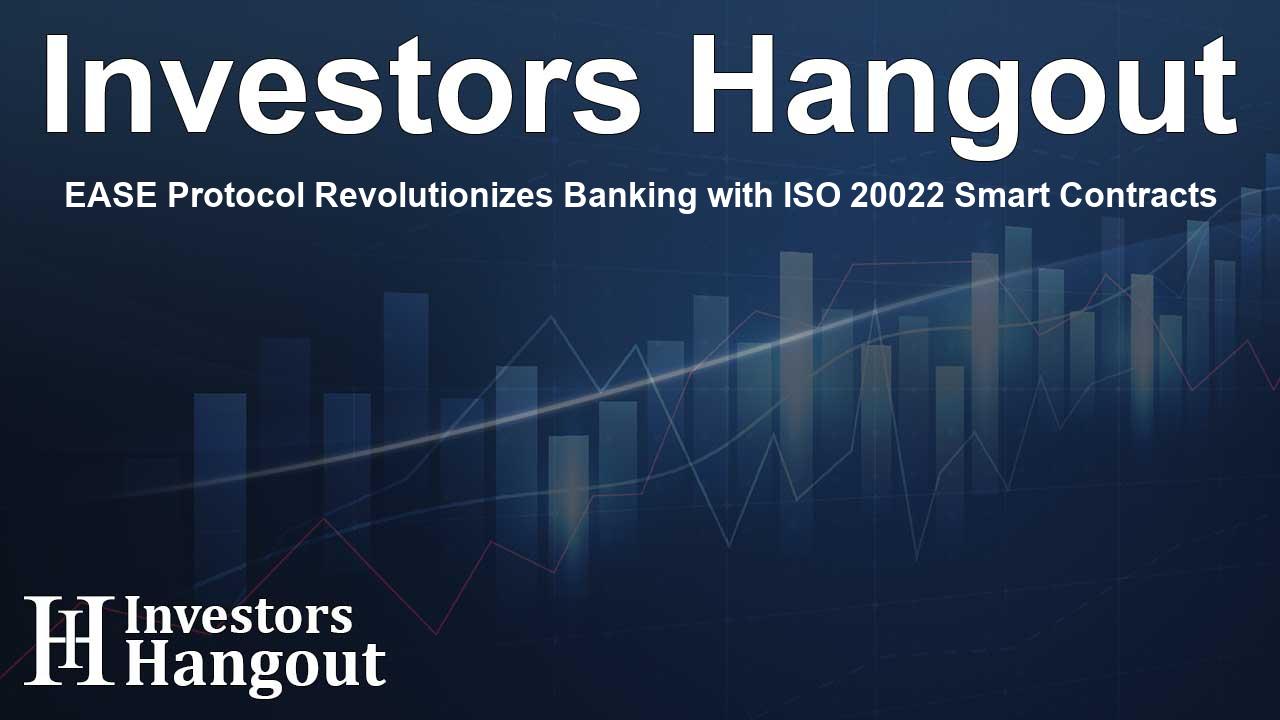EASE Protocol Revolutionizes Banking with ISO 20022 Smart Contracts

EASE Protocol Makes History with ISO 20022 in Smart Contracts
The EASE Protocol, a pioneering blockchain platform recognized for its focus on usability and adoption, has achieved a remarkable milestone by integrating ISO 20022 messaging standards into blockchain smart contracts. This venture heralds a significant leap in financial technology, allowing banks and institutions to optimize their banking processes within various blockchain environments.
Transforming Financial Messaging Standards
ISO 20022 is set to replace the traditional SWIFT messaging system, creating a vital framework for secure financial communications worldwide. With EASE Protocol now incorporating these standards directly into smart contracts, it unlocks the potential for automation in banking, a game-changing shift that is likely to redefine operations in the financial sector. This seamless integration allows institutions to trial these innovative capabilities on the EASE Testnet before full-scale implementation.
Expert Insights on Integration
Douglas Horn, the architect behind EASE Protocol, emphasized the significance of this advancement. "Integrating ISO 20022 messaging into smart contracts is a crucial step for traditional financial institutions to fully adopt blockchain technology. Our solution automates banking procedures, thereby increasing efficiency and lowering operational costs for banks." This powerful combination showcases how blockchain can drive global adoption of automated financial services.
Enhanced Cross-Chain Capabilities
At the heart of this implementation lies a sophisticated cross-chain bridging system that facilitates transactions between EASE and other Ethereum Virtual Machine (EVM) compatible blockchains, including Ethereum, Polygon, and Binance Smart Chain. Future enhancements will extend support to other key blockchains like Solana. Central to this operation is the Atomic Intermediate Token (AIT), which allows for streamlined cross-chain transactions. When AIT tokens cross from the EASE blockchain to an EVM chain, they are managed through the EASE Bridge Manager smart contract.
Ensuring Compliance and Efficiency
Every bridge transaction follows ISO 20022 format, ensuring that all operations meet the expectations of global financial institutions that are transitioning towards adopting these standards. This meticulous attention to compliance provides a significant edge for financial organizations, allowing them to enhance efficiency while ensuring regulatory adherence.
A Competitive Advantage for Financial Institutions
The new capabilities offered by EASE Protocol go beyond simple token transfers. The upcoming bridge system will also facilitate the exchange of messages and actions related to ISO 20022, enabling a more integrated approach to smart contract interactions. This functionality positions banks to leverage cross-chain operations effectively, with unmatched speed and reduced costs in settlement processes.
Future Outlook for Blockchain in Banking
“Blockchain technology carries immense potential to streamline the traditional banking infrastructure,” stated Horn, now serving as CEO of EASE Protocol Inc. He believes this new integration finally fulfills blockchain's promise of driving efficiency within the banking sector, presenting a compelling incentive for banks to explore blockchain solutions.
About EASE Protocol
EASE Protocol is an innovative blockchain platform engineered to break down barriers that hinder blockchain adoption in various sectors, notably in government and enterprise applications. With features like Single Sign-On, advanced security measures, and cross-chain functionalities, it provides essential tools for organizations looking to implement scalable blockchain technology. EASE Protocol aims to deliver transformative solutions tailored to the unique needs of enterprises.
Frequently Asked Questions
What is the significance of ISO 20022 in blockchain?
ISO 20022 enhances financial messaging standards, allowing for better automation and communication between financial institutions using blockchain technology.
How does EASE Protocol work with cross-chain transactions?
EASE Protocol utilizes a bridging system that manages transactions between EASE and EVM-compatible blockchains like Ethereum and Binance Smart Chain, ensuring efficient operations.
What are the benefits of automating banking processes?
Automating banking processes leads to increased operational efficiency, reduced costs, and improved transaction speeds, benefiting financial institutions significantly.
Who is behind the EASE Protocol?
The EASE Protocol was developed by a team led by Douglas Horn, who is committed to advancing the integration of blockchain technology in financial services.
How can organizations learn more about EASE Protocol?
Organizations interested in EASE Protocol can access detailed technical information in their comprehensive whitepaper, available on their official site.
About The Author
Contact Hannah Lewis privately here. Or send an email with ATTN: Hannah Lewis as the subject to contact@investorshangout.com.
About Investors Hangout
Investors Hangout is a leading online stock forum for financial discussion and learning, offering a wide range of free tools and resources. It draws in traders of all levels, who exchange market knowledge, investigate trading tactics, and keep an eye on industry developments in real time. Featuring financial articles, stock message boards, quotes, charts, company profiles, and live news updates. Through cooperative learning and a wealth of informational resources, it helps users from novices creating their first portfolios to experts honing their techniques. Join Investors Hangout today: https://investorshangout.com/
The content of this article is based on factual, publicly available information and does not represent legal, financial, or investment advice. Investors Hangout does not offer financial advice, and the author is not a licensed financial advisor. Consult a qualified advisor before making any financial or investment decisions based on this article. This article should not be considered advice to purchase, sell, or hold any securities or other investments. If any of the material provided here is inaccurate, please contact us for corrections.
